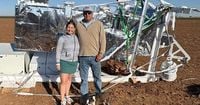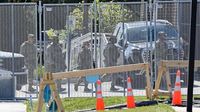On a crisp October morning in Edmonson, Texas, Ann Walter was enjoying the quiet of her rural home when a spectacle unfolded overhead that would soon draw the attention of NASA, local law enforcement, and curious neighbors alike. What she first perceived as an oddly bulky object floating serenely across the sky soon revealed itself to be a massive boxy structure, attached to a parachute so large that it dwarfed anything she’d ever seen drifting above the wheat fields.
As Walter watched, the object—about the size of a sport-utility vehicle—descended gently, guided by a parachute she later estimated to be nearly 30 feet in diameter. It landed with little drama in her neighbor’s wheat field, but the sense of wonder and confusion that followed was palpable. “It’s crazy, because when you’re standing on the ground and see something in the air, you don’t realize how big it is,” Walter recalled, according to the Associated Press. “It was probably a 30-foot parachute. It was huge.”
Walter’s curiosity quickly turned to concern. The boxy payload was adorned with unmistakable NASA stickers, suggesting it was no ordinary farm debris. Unsure of what to do next, she called the Hale County Sheriff’s Office. The sheriff, David Cochran, confirmed that NASA had indeed contacted his office in search of a missing piece of scientific equipment. As it turned out, Walter had stumbled upon a wayward artifact of space science—one that had traveled over 140 miles from its launch site in Fort Sumner, New Mexico, before making its unexpected touchdown in West Texas.
The equipment belonged to NASA’s Columbia Scientific Balloon Facility, a program renowned for launching large, unmanned high-altitude balloons more than 20 miles into the atmosphere. These balloons aren’t just for show—they’re loaded with cutting-edge telescopes and sensors designed to collect data on stars, galaxies, black holes, and a host of other cosmic phenomena. The equipment that landed in Edmonson had been launched just one day prior, as confirmed by the facility’s publicly available schedule. Its mission: to probe the mysteries of the universe from a vantage point high above the atmospheric haze that blurs ground-based observations.
According to Spectrum News, the Columbia Scientific Balloon Facility’s launches from Fort Sumner are a regular occurrence, but the recovery of their payloads doesn’t always make headlines—unless, of course, one lands in a Texas wheat field. “The researchers came out with a truck and trailer they used to pick it up,” Walter said. Before the NASA team arrived, however, Walter and her family seized the opportunity to document the surreal event, snapping photos and recording videos of the car-sized apparatus and its billowing parachute. “It’s kind of surreal that it happened to us and that I was part of it,” she reflected. “It was a very cool experience.”
The incident, reported by multiple outlets including the Associated Press and Spectrum News, highlights both the ambition and unpredictability of high-altitude scientific research. NASA’s balloon program is a critical part of the agency’s effort to push the boundaries of astronomical discovery. By lofting sophisticated instruments high above the Earth, scientists can observe the cosmos with far less atmospheric distortion, capturing clearer images and more precise data than would be possible from the ground. These flights contribute to our understanding of everything from the birth of stars to the dynamics of black holes, providing insights that shape our view of the universe.
But with great ambition comes the occasional logistical hiccup. High-altitude balloons are at the mercy of wind patterns and weather conditions, making their eventual landing spots difficult to predict with pinpoint accuracy. NASA’s recovery teams are accustomed to tracking and retrieving their equipment across vast distances, but the involvement of local residents and law enforcement is not uncommon. In this case, the recovery effort was further complicated by an ongoing government shutdown, which had impacted NASA’s operations and limited official responses to media inquiries.
Despite these challenges, coordination between NASA, the Hale County Sheriff’s Office, and the Walters ensured a smooth retrieval. The researchers arrived with a truck and trailer, carefully loading the equipment for transport back to the Columbia Scientific Balloon Facility. For the Walters, the event was a once-in-a-lifetime brush with the frontiers of science—a reminder that even in the quietest corners of rural Texas, the wonders of exploration can quite literally fall from the sky.
The story of the parachuting NASA payload quickly became a topic of local conversation, sparking both amusement and fascination. It’s not every day that a piece of cutting-edge scientific apparatus lands in a wheat field, after all. The episode also offered a rare, up-close look at the technology that powers humanity’s quest to understand the universe. For Walter and her neighbors, the encounter transformed a typical day into an extraordinary adventure, blending the marvels of space science with the rhythms of rural life.
As reported by the Associated Press and corroborated by Spectrum News, the equipment’s journey from Fort Sumner to Edmonson is a testament to the reach—and unpredictability—of NASA’s scientific endeavors. The high-altitude balloon that carried the payload had soared more than 20 miles above the Earth, collecting data on cosmic phenomena before its descent. The fact that it landed safely, without causing damage or injury, speaks to the careful design and planning behind these missions, even as it underscores the inherent uncertainties of sending instruments aloft on the winds.
For the scientific community, incidents like this one are more than just curiosities—they’re opportunities to refine recovery protocols and engage with the public about the importance of research. For the residents of Edmonson, it’s a story that will be told for years to come: the day NASA came calling, and a Texas wheat field became the unlikely landing pad for a mission to the stars.
In a world where headlines are often dominated by routine or misfortune, the sight of a NASA payload drifting down from the stratosphere offered a moment of wonder and connection. It was, as Ann Walter put it, “a very cool experience”—and one that turned a quiet morning into a chapter of scientific history for a small Texas town.





